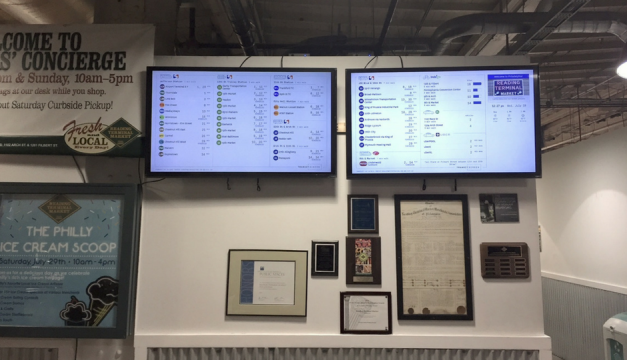Reading Terminal Market Just Got a Much Needed Tech Upgrade

TransitScreen display mounted on the back wall of Reading Terminal Market | Photo courtesy of TransitScreen
Shoppers can now be even more care-free when strolling the aisles of Reading Terminal Market. Thanks to the addition of two LED flat-screens to the market’s back wall, visitors can see live-updated information on the status of their rides home.
The new TransitScreen displays use open source API data to show arrival times and availability information for SEPTA (buses, trains, and trolleys) and PATCO, and even availability for bikes via Indego and cars via Zipcar, and Uber.
“Because the display lists the intersection where the station is and how far of a walk it is from Reading Terminal, someone will know if they have time to get there,” TransitScreen communications manager Rachel Karitis told Philadelphia magazine. And the screens display the routes of select bus, train and trolley lines.
TransitScreen has already installed the displays in eight other locations across the city – but none are nearly as centralized and highly trafficked as Reading Terminal. “It’s such an iconic location,” says Karitis, “and definitely more public. The screens we’ve previously installed in Philadelphia are all in apartment lobbies, commercial office lobbies. This one definitely stands out.”

Example TransitScreen display | Photo courtesy of TransitScreen
The Washington D.C.-based software company has installed its streamlined information boards in 33 cities across the world since 2013. The company’s hope is that by making people aware of different transportation options in their area, the screens will promote sustainability and accessibility in major metropolitan areas.
Even by eliminating the need to shuffle through multiple apps to check various options, the screens make it easier for people to access different transit modes. And hopefully people will diversify their transit choices in the process. “A lot of the time,” says Karitis, “what makes people hesitant to take another form of public transit is not knowing when it’s coming.”
The addition is also in line with Reading Terminal GM Anuj Gupta‘s push to integrate more tech into the old space as it approaches 125 years of continuous operation. TransitScreen estimates that about 500,000 people across the world see their screens each day.
Follow @HaleySWeiss on Twitter.


